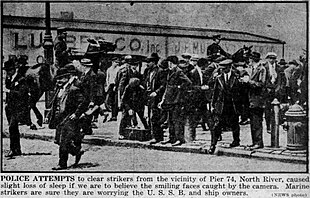The Railway Labor Act is a United States federal law that governs labor relations in the railroad and airline industries. The Act, enacted in 1926 and amended in 1934 and 1936, seeks to substitute bargaining, arbitration, and mediation for strikes to resolve labor disputes. Its provisions were originally enforced under the Board of Mediation, but they were later enforced under a National Mediation Board.

New York Harbor is at the mouth of the Hudson River where it empties into New York Bay near the East River tidal estuary, and then into the Atlantic Ocean on the United States East coast.

The Seattle General Strike was a five-day general work stoppage by 65,000 workers in the city of Seattle, Washington from February 6 to 11, 1919. The goal was to support shipyard workers in several unions who were locked out of their jobs when they tried to strike for higher wages. Most other local unions joined the walk-out, including members of the American Federation of Labor (AFL) and the Industrial Workers of the World (IWW). The national offices of the AFL unions were opposed to the shutdown. Local, state and federal government officials, the press, and much of the public viewed the strike as a radical attempt to subvert American institutions.

The International Longshoremen's Association (ILA) is a North American labor union representing longshore workers along the East Coast of the United States and Canada, the Gulf Coast, the Great Lakes, Puerto Rico, and inland waterways; on the West Coast, the dominant union is the International Longshore and Warehouse Union. The ILA has approximately 200 local affiliates in port cities in these areas.
Mexican labor law governs the process by which workers in Mexico may organize labor unions, engage in collective bargaining, and strike. Current labor law reflects the historic interrelation between the state and the Confederation of Mexican Workers, the labor confederation officially aligned with the Institutional Revolutionary Party, which ruled Mexico under various names for more than seventy years.

The Great Railroad Strike of 1922, or the Railway Shopmen's Strike, was a nationwide strike of railroad workers in the United States. Launched on July 1, 1922 by seven of the sixteen extant railroad labor organizations, the strike continued into August before collapsing. A sweeping judicial injunction by Judge James Herbert Wilkerson effectively ended the strike on September 1, 1922.
The eight-hour day was a social movement to regulate the length of a working day, preventing excesses and abuses of working time.

The Biennio Rosso was a two-year period, between 1919 and 1920, of intense social conflict in Italy, following the First World War. The revolutionary period was followed by the violent reaction of the fascist blackshirts militia and eventually by the March on Rome of Benito Mussolini in 1922.

The International Organization of Masters, Mates & Pilots or MM&P is a United States labor union representing licensed mariners.
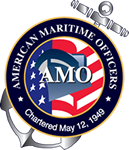
American Maritime Officers (AMO) is a national labor union affiliated with the Seafarers International Union of North America. With an active membership of approximately 4,000, AMO represents licensed mariners working in the United States Merchant Marine aboard U.S.-flagged merchant and military sealift vessels. AMO holds a unique presence in the international energy transportation trades.
The National Maritime Union (NMU) was an American labor union founded in May 1937. It affiliated with the Congress of Industrial Organizations (CIO) in July 1937. After a failed merger with a different maritime group in 1988, the union merged with the Seafarers International Union of North America in 2001.
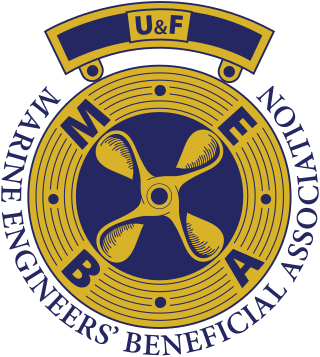
The Marine Engineers' Beneficial Association (MEBA) is the oldest maritime trade union in the United States still currently in existence, established in 1875. MEBA primarily represents licensed mariners, especially deck and engine officers working in the United States Merchant Marine aboard US-flagged vessels. It is a member union of the AFL–CIO.

The Ministry of Labour was a British government department established by the New Ministries and Secretaries Act 1916. It later morphed into the Department of Employment. Most of its functions are now performed by the Department for Work and Pensions.
Cyrus S. Ching was a Canadian-American who became an American industrialist, federal civil servant, and noted labor union mediator. He was the first director of the Federal Mediation and Conciliation Service (FMCS) and the Wage Stabilization Board.

The Railroad Labor Board (RLB) was an institution established in the United States of America by the Transportation Act of 1920. This nine-member panel was designed as means of settling wage disputes between railway companies and their employees. The Board's approval of wage reductions for railroad shopmen was instrumental in triggering the Great Railroad Strike of 1922. The Board was terminated on May 20, 1926 when President Calvin Coolidge signed a new Railway Labor Act into law.

The Los Angeles streetcar strike of 1919 was the most violent revolt against the open-shop policies of the Pacific Electric Railway Company in Los Angeles. Labor organizers had fought for over a decade to increase wages, decrease work hours, and legalize unions for streetcar workers of the Los Angeles basin. After having been denied unionization rights and changes in work policies by the National War Labor Board, streetcar workers broke out in massive protest before being subdued by local armed police force.

During the strike wave of 1945–46 a strike of almost 3,500 tugboat workers occurred on Monday February 1, 1946. The expectations of the strike were to bring the world's busiest harbor to a virtual standstill. Captain William Bradley, president of Local 333, United Maritime Division, International Longshoremen's Association, stated two days before the actual strike that a strike vote had been taken the previous week-end, during a breakdown of negotiations with the Employers Wage Adjustment Committee, which represents the owners and operators in this port.
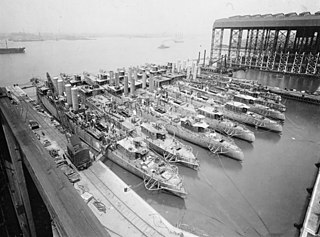
The New York Shipbuilding strike was a strike that occurred in the Port of Camden, New Jersey, in the spring of 1934 by the New York Shipbuilding Company. Around 3,100 men took part in the 7-week action, centered at the company's Camden, New Jersey construction yard.
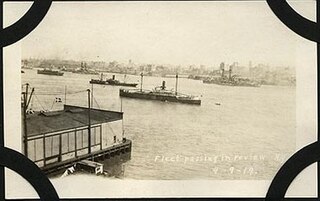
The New York City Harbor Strike of 1919 started on January 9, 1919. It involved 15,000–16,000 workers striking after it was called by the executive committee of the Marine Workers Union.

The United States strike wave of 1919 was a succession of extensive labor strikes following World War I that unfolded across various American industries, involving more than four million American workers. This significant post-war labor mobilization marked a critical juncture in the nation's industrial landscape, with widespread strikes reflecting the heightened socioeconomic tensions and the burgeoning demand for improved working conditions and fair labor practices.
